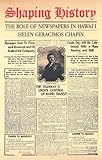Shaping History : The Role of Newspapers in Hawaii / Helen Geracimos Chapin.
Material type: TextPublisher: Honolulu : University of Hawaii Press, [1996]Copyright date: ©1996Description: 1 online resource (400 p.)Content type:
TextPublisher: Honolulu : University of Hawaii Press, [1996]Copyright date: ©1996Description: 1 online resource (400 p.)Content type: - 9780824864279
- 079.969
- PN4897.H33.C48 1996eb
- online - DeGruyter
| Item type | Current library | Call number | URL | Status | Notes | Barcode | |
|---|---|---|---|---|---|---|---|
 eBook
eBook
|
Biblioteca "Angelicum" Pont. Univ. S.Tommaso d'Aquino Nuvola online | online - DeGruyter (Browse shelf(Opens below)) | Online access | Not for loan (Accesso limitato) | Accesso per gli utenti autorizzati / Access for authorized users | (dgr)9780824864279 |
Browsing Biblioteca "Angelicum" Pont. Univ. S.Tommaso d'Aquino shelves, Shelving location: Nuvola online Close shelf browser (Hides shelf browser)

|

|

|

|

|

|

|
||
| online - DeGruyter Seascapes : Maritime Histories, Littoral Cultures, and Transoceanic Exchanges / | online - DeGruyter Selling Songs and Smiles : The Sex Trade in Heian and Kamakura Japan / | online - DeGruyter Shanghai Express : A Thirties Novel / | online - DeGruyter Shaping History : The Role of Newspapers in Hawaii / | online - DeGruyter Sherlock in Shanghai : Stories of Crime and Detection by Cheng Xiaoqing / | online - DeGruyter Shifting Shape, Shaping Text : Philosophy and Folklore in the Fox Koan / | online - DeGruyter Shinto : The Way Home / |
Frontmatter -- Contents -- Acknowledgments -- Introduction -- PART I: “To Exhibit Truth in an Attractive Form”: An Establishment Press Arrives—1834–1850 -- 1. Ka Lama: “The Light” Is Brought to Hawai‘i -- 2. The Solemn Responsibility of Dissent -- 3. The Polynesian: In the Service of America and the Kingdom -- 4. The English Flag and the English Language -- 5. God Gives Way to Mammon: The Mahele of 1848 -- PART II:“Fiery Polemic Contests” for the Public’s Support— 1850–1887 -- 6. The Honolulu Times Welcomes the City of Honolulu -- 7. The Chinese Arrive -- 8. A Prophet Without Profit: Fornander Topples Judd -- 9. The Advertiser Enters History -- 10. A Hawaiian Nationalist Press Is Born -- 11. “A New Era Has Dawned”: Sugar Is King -- 12. The Politics of Health -- PART III: Nationalists versus the Oligarchy: An Uneven Battle—1887–1899 -- 13. A Pan-Pacific Dream -- 14. Robert Wilcox, “the Napoleon of Printers’ Lane” -- 15. Revolution and the Suppression of Freedom of Speech -- 16. The Republic Burns Down Chinatown -- PART IV:“Here to Stay”: A U.S. Territory— 1900–1941 -- 17. Annexation and the Pacific Cable -- 18. The 1909 Strike and the Japanese Language Press -- 19. Respected Residents Become the Enemy: World War I and the Germans -- 20. Suppressing the News and Contributing to a Massacre -- 21. The Three Rs—Reading, ’Riting, and Racism -- 22. “Reclaiming” Waikîkî for the “Aloha Spirit” -- 23. Getting Away With Murder: The Massie Case -- 24. Hilo’s “Bloody Monday”: The Tribune-Herald and the Voice of Labor -- PART V: “Passed for Publication”— 1941–1945 -- 25. A Wartime Press and the Paradox of Censorship for Freedom -- 26. AJAs: American Patriots -- PART VI: The March toward Statehood— the 1940s and 1950s -- 27. “Dear Joe”: Lorrin Thurston Writes to Joe—Stalin or Farrington? -- 28. The Honolulu Record and the Art of Muckraking -- 29. The Hawaii Seven: Journalists in Jeopardy -- 30. Ka Leo Reports on the Golden Rule -- 31. Watch Them Grow: Tourism and Suburban O‘ahu -- 32. Statehood and the Star-Bulletin -- PART VII :The Turbulent 1960s -- 33. The Business of Newspapers -- 34. The Popular Columnist -- 35. Sports and Journalism: “The Social Fabric” -- 36. Above Ground: The Battle for Diamond Head -- 37. Underground: The Battle for Hawai‘i’s Soul -- 38. Women in the News: From Society to Social Causes -- PART VIII:From Satellite City Halls to a Satellite Universe— 1970–1976 -- 39. Memories of Maui -- 40. Corporate Economics and Chain Papers -- 41. Fighting the Newspapers to a Draw: Frank Fasi and the Dailies -- 42. The Public Opinion Poll -- 43. Anger and Wit: The Political Cartoon -- 44. Hawaiian Sovereignty and a Satellite Universe, 1976 -- Bibliography -- Index -- About the Author
restricted access online access with authorization star
http://purl.org/coar/access_right/c_16ec
Just a decade after the first printing press arrived in Honolulu in 1820, American Protestant missionaries produced the first newspaper in the islands. More than a thousand daily, weekly, or monthly papers in nine different languages have appeared since then. Today they are often considered a secondary source of information, but in their heyday Hawai‘i’s newspapers formed one of the most diversified, vigorous, and influential presses in the world. In this original and timely work, Helen Geracimos Chapin charts the role Hawai‘i’s newspapers played in shaping major historic events in the islands and how the rise of the newspaper abetted the rise of American influence in Hawai‘i. Shaping History is based on a wide selection of written and oral sources, including extensive interviews with journalists and others working in the newspaper industry. Students of journalism and Hawaiian history will find this comprehensive history of Hawai‘i’s newspapers especially valuable.
Mode of access: Internet via World Wide Web.
In English.
Description based on online resource; title from PDF title page (publisher's Web site, viewed 02. Mrz 2022)


